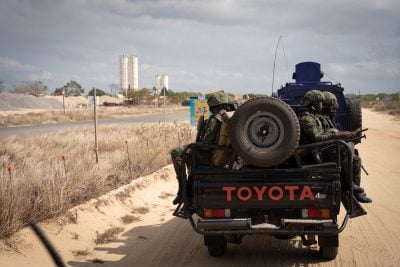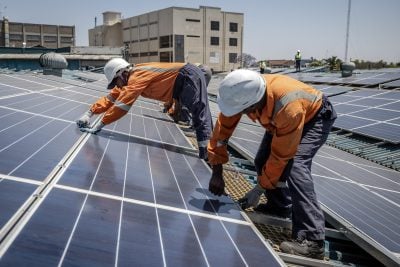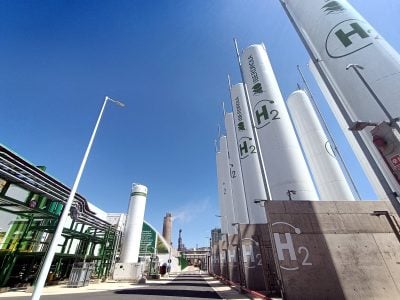To say South Africa’s south-eastern KwaZulu-Natal (KZN) province has had a difficult year would be a gross understatement.
In April this year, four months’ worth of rain fell on the province in just one day, causing its worst flooding in more than six decades. More than 400 people died in the floods, 4,000 homes were destroyed and over 40,000 people were displaced. Hundreds of jobs were lost and businesses were destroyed, many without insurance. The catastrophe caused billions of rands worth of damage and led the government to declare a state of disaster.
The floods followed of some of the country’s worst violence since the days of apartheid in July 2021, when some 354 people died in unrest stoked by followers of former President Jacob Zuma after he was jailed on contempt of court charges.
Anger over high unemployment and widening economic inequality meant the violence then spread like wildfire across the KZN and Gauteng provinces. Scores of shops and businesses were looted, their assets plundered.
The city of Durban estimated that the riots cost it more than $1bn in damages and lost goods, which, along with the 129,000 jobs that were put at risk, could amount to $1.4bn being wiped off its gross domestic product. Even before the floods, it was estimated that it would take the port city’s economy years to fully recover.
Waterlogged port
The floods toppled houses and upended heavy shipping containers, some of which floated like dinghies down Durban’s highways. Operations at the city’s port – the largest in Africa – were completely disrupted for several days.
Nompumelelo Dweba-Kwetana, the manager of the port of Durban, says the port had to be closed on 8 April due to the heavy rains.
Three rivers – aManzimnyama, uMhlatuzana and uMbilo – and 52 canals run into the port, all of which were washing debris from nearby informal settlements downstream towards the sea. Bridges and critical port infrastructure were ravaged.
“The canals and the bridges were blocked, so the water had to find means of pushing through, because it was coming from the city into the port. It was sweeping over everything,” Dweba-Kwetana tells African Business.
The port’s shipping container terminal and Island View terminal – where petrochemical companies make their shipments – were severely waterlogged, as was the Bayhead Road, the main artery from the port into the city, which carries between 12,000 and 13,000 trucks a day. Some port workers were also trapped on site for a few days due to the road being submerged.
“If the Bayhead Road is washed away, it means there is literally no link to the hinterland,” Dweba-Kwetana says, adding that fuel companies were severely hit by the downpour.
“They were actually unable to supply fuel to the service stations as a result of the closure of Bayhead Road. So there was the shortage of fuel supply, and also there was a shortage of essential cargo, which is containerised in some of the warehouses and the depots,” she adds.
With essential cargo and fuel unable to leave the port, port and city officials had to engage with the nearby Bluff community to use Bluff Road as an alternative exit to transport the fuel and cargo while officials worked to remove the water and detritus from Baywater Road.
Although shipping resumed at the port on 14 April, business did not stabilise for another four days, Dweba-Kwetana says.
Felt in Durban and beyond
The full economic cost of the floods is still to be calculated, but recent estimations by the government have put the figure at R17bn ($1bn). Industry sentiment has also been severely affected. For example, in April the Absa purchasing managers’ index, which measures manufacturing sentiment, plummeted to 50.7 from 60 prior to the floods, its biggest fall in nine months.
Small and medium enterprises (SMEs) were the most badly affected by the floods, according to Gladwin Malishe, deputy president at the Durban Chamber of Commerce and Industry NPC.
“Many of them lost absolutely everything – even money to go and re-buy stock was gone. They don’t even have some of the papers to say that can prove that ‘I had a business here’,” Malishe tells African Business.
The Durban Chamber represents around 3,000 businesses in the city, and roughly 70% of them are SMEs. After July 2021’s unrest, it worked with Old Mutual and the Domino Foundation to provide financial support to SMEs impacted by the floods.
The Chamber said on 18 April that it had asked the government to restore water to key business nodes, warning that failure to do so could lead to economic collapse. It has also been pushing for electricity to be restored in these locations as soon as possible.
“If you have any problems with Durban, it means the economy is actually standing still in South Africa,” Malishe says.
He says it was not only the fuel industry that was badly hit. “The manufacturers export cars, export chemicals, and many of them have halted exporting because they can’t really take their stock out until some part of the infrastructure is actually fixed.”
The floods have had a “huge impact” on South Africa’s economy, Malishe says, with KZN contributing about 16% of national GDP. KZN is the second-highest contributing province after Gauteng, which contains Johannesburg and Pretoria.
As Africa’s largest port and a key gateway to the South African Development Community (SADC) economies, including Angola, Botswana, Mozambique, Zambia and Zimbabwe, the effects of the floods are being felt way beyond the city limits.
Climate change and poor city planning
The South African government has blamed the floods mainly on climate change but has also admitted that poor city planning made some communities particularly vulnerable.
“We needed to do something,” Dweba-Kwetana says. “At TNPA [Transnet National Ports Authority], our chief executive has requested that we establish a team called the Climate Change team. They are looking at how we ensure that we get ready as a port for such types of storms and floods in the future.
“We are also working closely with the city in terms of dealing with the infrastructure to make sure it is at least able to handle such incidents in the future.”
Malishe says the floods send a strong message to prioritise replanning Durban’s infrastructure.
“Right now, we don’t really have the efficiency in terms of public transport and also it’s very expensive, hence why they need to attract people to be closer to work,” he says.
“We are hoping that government first and foremost will be able to come up with a very clear plan in terms of the public transport system that we need to have, but also to move people to better land [with] infrastructure like drainage and so on, and we’ll be able to have proper houses in those areas.”
Malishe stresses that the private and public sectors need to work closely together to help KZN recover from the floods.
“If there are issues of unemployment, let us work together to solve them. If there are issues of business and corruption let’s work together to solve them. Because this is our country, we need to work together to make it work,” he says.
The KZN provincial government is negotiating with South Africa’s National Treasury on the allocation of disaster funds to the tune of R1bnto help the city recover from the floods and build defences to minimise the impact of future downpours.
The city of Durban is developing a Transformative River Management Programme (TRMP), supported by the 40 City Finance Facility (CFF), which aims to adapt the 7,400km of streams and rivers in the city to the flooding, drought and higher temperatures brought by climate change.
One way the project is doing this is by creating local jobs for people to remove invasive plant species from the river beds, which will reduce stormwater blockages that can lead to deadly flooding in riverside communities. The project is estimated to cost $1 billion over 10 years and is mainly being funded by the eThekwini municipality.
After holding talks with the Durban chamber and local business leaders on May 15, President Cyril Rampahosa conceded that the government was not as “ready as it should be” for the floods in KZN. He committed to “climate proofing” his government so that responses to national disasters like the floods can be dealt with in a more “resilient” manner.
Want to continue reading? Subscribe today.
You've read all your free articles for this month! Subscribe now to enjoy full access to our content.
Digital Monthly
£8.00 / month
Receive full unlimited access to our articles, opinions, podcasts and more.
Digital Yearly
£70.00 / year
Our best value offer - save £26 and gain access to all of our digital content for an entire year!
 Sign in with Google
Sign in with Google 



